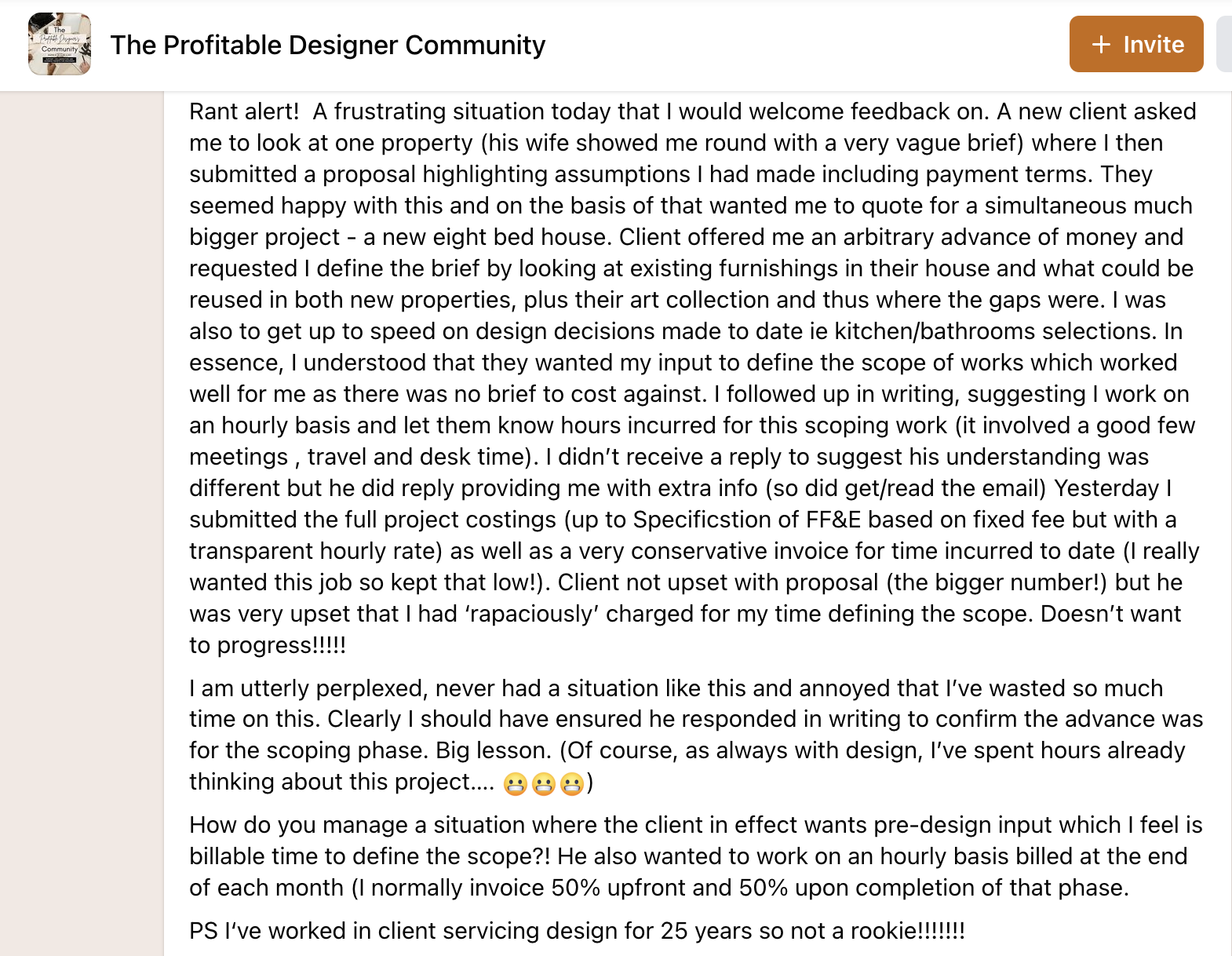Community Q&A: How to avoid time wasters before you sign a contract
In this community Q&A series I answer questions that come up in my Facebook group and outline my thoughts on what people are asking.
If you want to submit a question for me to answer for this series make sure to join the Facebook group and post your question!
In this post we look at a scenario where expectations between client and designer are misaligned, resulting in the designer doing work for free.
Here are my thoughts on this:
Charge for an initial design consultation: I would always start every project with a paid initial design consultation (I explain why here). The purpose of this consultation is for the client to get to know you AND for you to get to know the client (to see if there is a mutual fit to work together). But this consultation is also a chance to talk about initial payment terms, especially if a scope isn’t yet clear. Accepting the ‘arbitrary sum of money’ was the issue here. Some specific payment terms and invoicing PRIOR to doing any work on this project should have been agreed to.
Clear communication: Always ensure you have clear and open lines of communication with a new client. This means discussing your expectations regarding payment, project scope and any other relevant details before beginning ANY work on the project. This takes client leadership (as many clients don’t understand how the design process works and it is up to us to explain this to them). Don’t let clients walk all over you - it’s important to make sure you set the boundaries and stick to them.
Written confirmation: Once you've discussed the project scope, payment terms and other details, get everything in writing. In a situation like above this might be before a formal contract or client agreement is prepared and signed. So the payment terms for scoping this project may just have been a simple email and invoice that you send to the client to get their agreement before moving forward with any work. Make sure your client confirms their agreement to these terms in writing (e.g. by response to the email). Also make sure to invoice for 50% of the work before you start and 50% once delivered. Do not start any work without some form of payment.
Set boundaries: Establish clear boundaries for what work is considered billable and what is not. Make sure your client understands these boundaries and is clear that scoping isn’t a service you provide for free.
Break down project phases: In all fee proposals I prepared for clients I would divide the project into clear phases, each with a specific deliverable and a payment schedule. This always helped the client understand the project timeline and budget and what payments were due when. I would also repeat this information in a Client Welcome Pack, which is a great place to set a lot of the expectations I’ve been outlining here.
Don’t work for free: A reminder that you’re running a business and not a charity. It can be tempting to start working for a client when you’re excited about a potential project and want to impress them or win the work. But you are a service provider and your time is your money. Don’t start any work without some form of payment from a client based on agreed terms - no matter how excited you are about a project.
If you want to read the rest of the industry views on this post then make sure to join my free community Facebook group where you can read the responses to this post and many more like it (plus ask your own questions as well).
What I've said in this post isn't directed at the person who wrote the post, it’s just a chance to write out my thoughts on the topic.
Thanks for reading and catch you in my next post :)
Clare x
Dr Clare Le Roy
Courses and Templates for Designers and Architects
DO YOU WANT TO….
Improve your professionalism?
Find more clients?
Bring in more revenue?
Create better systems and processes?
Then check out my business courses and templates for designers and architects.
These courses and templates leave you with work done - not just a long list of things you need to do next. We have a really strong focus on taking action and getting things created that improve your business.



